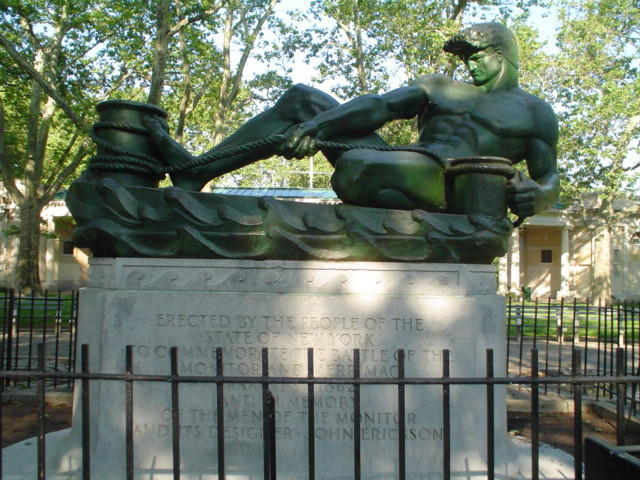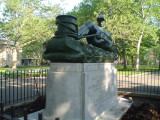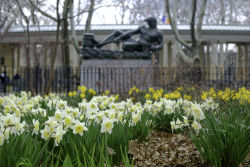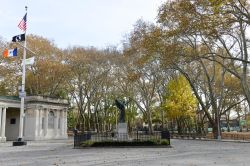Msgr. McGolrick Park
View all monuments in NYC Parks, as well as temporary public art installations on our NYC Public Art Map and Guide.
Monitor Memorial
| Artist: | Antonio de Filippo |
| Dedicated: | November 6, 1938 |
| Location: | Nassau and Driggs Avenues, and Russell and Monitor Streets |
Artwork History
Who is this monument dedicated to?
This statue honors the esteemed Swedish American engineer and inventor John Ericsson (1803–1889), as well as the Monitor, the ironclad ship he designed.
Ericsson was born in Langbanshyttan, Sweden on July 31, 1803. He displayed a talent for engineering, building a miniature sawmill before he was eleven. His precocious ability caught the attention of the well-known engineer Count Platen, who appointed Ericsson at age twelve a cadet in the corps of mechanical engineers. After six months of training Ericsson was made a “leveller” at the grand Swedish canal construction, and at age fourteen he was placed in charge of 600 soldier operatives, while he himself made mechanical drawings for the canal project.
Ericsson entered the Swedish Army in 1820 and was rapidly promoted from ensign to lieutenant. Resigning his post in 1827, he produced a sea sounding instrument, a hydrostatic weighing machine, and a self-acting gun lock for naval cannons, among many devices he invented. Ericsson moved to London, England, where he dedicated much of the next decade to improving methods of land and sea steam locomotion.
In 1836, he invented and patented the screw propeller, a device that vastly improved steam vessel travel, and caused Ericsson to prosper. Approached by the United States Navy, Ericsson came to the United States in 1839 and was engaged as superintending engineer for the Eastern Counties railway. His design for the United States Navy frigate, the Princeton, united many of his technological inventions, including state-of-the art screw propellers, smokestacks, ventilators, optical instruments, and gun carriages. However, a demonstration in 1844, in which a large gun accidentally exploded killing the United States secretaries of the navy and state, tarnished Ericsson’s reputation. Despite this setback, he sustained his engineering profession, and his career was revived in 1861 with the design and construction of the storied Monitor ironclad war ship.
The Monitor was the product of Ericsson’s response to the Confederacy’s intent in early 1861 to ironclad its warship, the Merrimac. Ericsson built the Monitor at Greenpoint’s Continental Iron Works, owned by local resident Thomas Fitch Rowland. The ship’s engine and machinery were fabricated in Greenwich Village at the Delamater Iron Works, with whom Ericsson was in partnership. The keel was laid on October 15, 1861, and within an astounding 100 days, the Monitor was launched from Greenpoint on January 30, 1862. Ericsson’s newfangled ship was put to the test in a famous battle against the Merrimac at Hampton Roads, Virginia on March 9, 1862, in which the Union forces averted defeat.
Ericsson’s success led to the construction of other similar vessels for military use both by Union, as well as foreign nations. For his efforts he had bestowed upon him many honors in the United States and Sweden, and from other European nations. He died in New York City on March 8, 1889.
How was this created?
In the 1930s the State of New York commissioned this statue to commemorate both the battle between the Monitor and the Merrimac and Ericsson. Created by the Italian American sculptor, Antonio de Filippo (1900–1993), this sculpture was dedicated in 1938. Rather than a portrait statue, such as Jonathan Scott Hartley’s bronze depiction of Ericsson (1903) which stands at the north side of Battery Park, de Filippo sculpted a monumental stylized male nude allegorical figure. The statue depicts a heroic male pulling a rope attached to a capstan, symbolizing Ericsson’s role in military-maritime technology and honoring the memory of the men of the Monitor. In the fall of 2000, through a city-funded capital project, the statue and pedestal were conserved.
Artwork Details
| Description: | Male figure (heroic scale) tugging at a hawser with an integral plinth, on a pedestal |
| Materials: | Bronze, granite |
| Donor: | State of New York |
| Cast: | ca. 1938 |
Inscription
(signed on integral plinth front): DE FILIPPO(on pedestal front): ERECTED BY THE PEOPLE OF THE / STATE OF NEW YORK / TO COMMEMORATE THE BATTLE OF THE / MONITOR AND MERRIMAC / MARCH 9TH, 1862 / AND IN MEMORY / OF THE MEN OF THE MONITOR / AND ITS DESIGNER - JOHN ERICSSON
Please note, the NAME field includes a primary designation as well as alternate namingsoften in common or popular usage. The DEDICATED field refers to the most recent dedication, most often, butnot necessarily the original dedication date. If the monument did not have a formal dedication, the yearlisted reflects the date of installation.
For more information, please contact Art & Antiquities at (212) 360-8163.
Check out your park's Vital Signs
Clean & Safe
Green & Resilient
Empowered & Engaged Users
Share your feedback or learn more about how this park is part of a
Vital Park System










